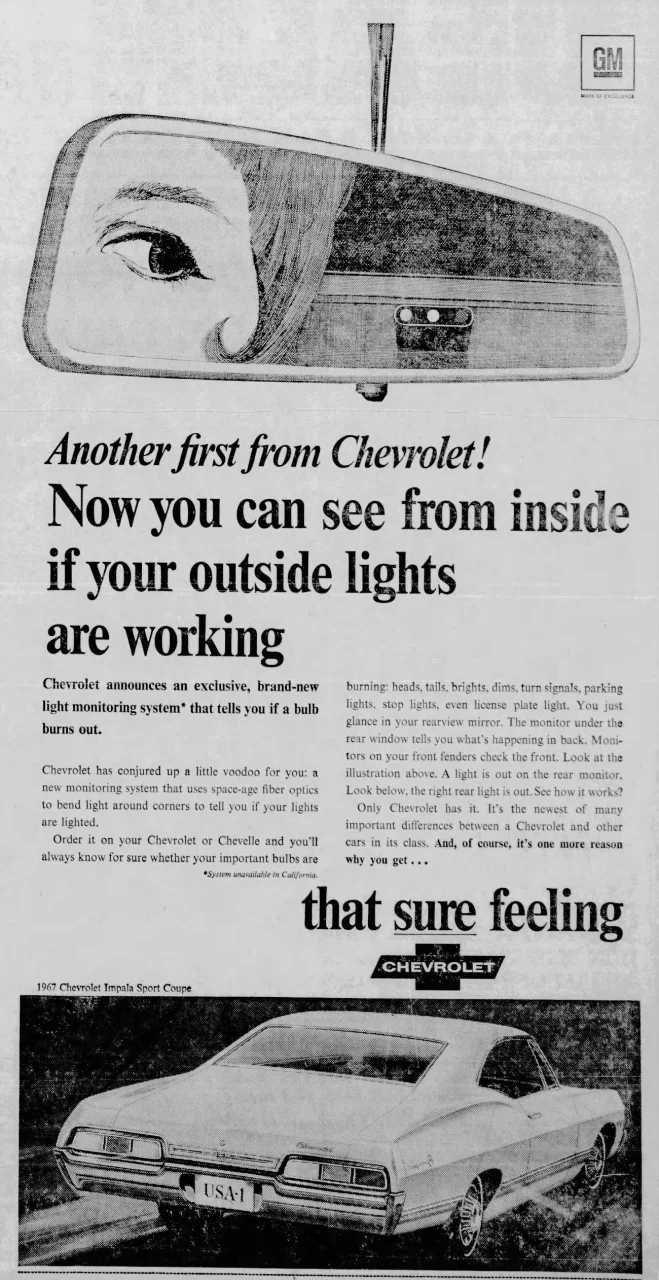It started with an email. My friend Adrian sent me a note stating, “I came across this interesting Chevrolet ad in the Monday, February 20, 1967, edition of the Gloucester County Times newspaper while doing some research on Ace Motor Sales and Eastlack Lincoln-Mercury, Inc. of Woodbury, New Jersey. Have you ever heard of this new ‘light monitoring system’ option? I wonder why it wasn’t available in California?”
I’ve seen this light monitoring system—later branded Vigilite—several times on Chevrolets, mainly 1968-69 models. It’s not a common option, being a feature that I would expect more on a Cadillac than the brand that was lowest on the General Motors totem pole. Digging into the 1967 full-size brochure, I found no mention of the option, though it appears in the 1968 catalog as a pair of fender-top monitors (versus the one pictured in the 1967 ad that sits on the rear package shelf). Logically, a vehicle should have both, so I will guess that I simply never noticed the interior monitor in cars that I have seen.

According to the ad, it was available in 1967 full-size Chevrolets and Chevelles, and I know it was expanded to Camaros for 1968. The option also was standard on the redesigned 1968 Corvette, though it was a set of monitor lights on the console.
I dove into old newspaper ads online and discovered this option was introduced in the middle of the model year. The first mention I found was a press release blurb in the January 26, 1967, edition of the Oakland (CA) Tribune.
Next, I grabbed my trusty Chevrolet SS Muscle Car Red Book, but the option was not listed for 1967 full-size or Chevelle models. However, ChevelleStuff.net shows 113 Chevelles were built with option code U46, which was introduced in February 1967. For full-size Chevrolets, the GM Heritage Center has provided a number of 1,107.

None of this addresses why cars sold in California could not be ordered with U46. Knowing that each state handles its affairs differently, it would not be unusual for something to be illegal in a particular state (the State of Pennsylvania had issues with the 1970 Plymouth Road Runner Superbird, for example). However, I did find this on the Internet:
CVC Section 25108(b–c) sets clear limits on external indicators used for monitoring functionality. Specifically:
- Exterior pilot indicators (like those used to show whether a lamp is functioning) must not exceed 0.20 square inches in lens area.
- Light intensity must be no more than 0.10 candlepower.
- Red lenses may not be visible from the front of the vehicle.
I do not know if this is particularly true for the light monitoring system in California, but I would be willing to bet the option ran afoul of state regulators.
If you know something about this, we would be appreciative if you chimed in!

